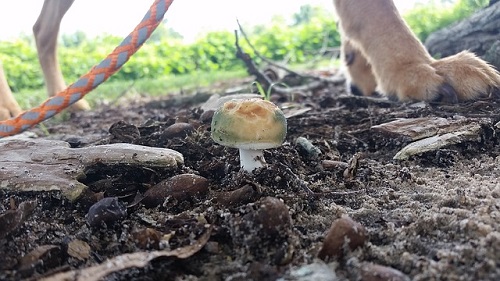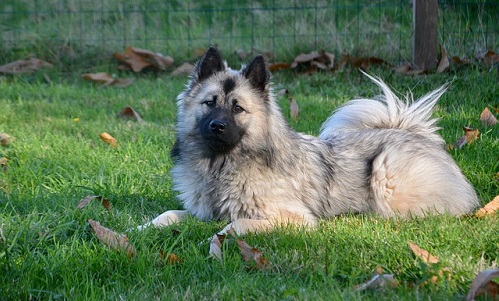Mushrooms. It’s likely you’re worried about your dog or family members consuming them as you’ve heard old wives tales about how poisonous they can be or because of their hallucinatory effects. But are the stories true?
Well, as most tales are, it’s complicated! Partly true and partly legend, and much of the “it depends” answer lies in which particular type of mushroom is in question, as there are hundreds of different mushroom varieties, and not all of them are toxic to dogs.
In this post, we’re going to cover mushroom toxicity in dogs to tell you which species cause problems, what signs and symptoms to watch out for if your dog has eaten some of those bad mushrooms, and what to do if your dog has indeed become ill as the result of ingesting mushrooms.
Which Mushrooms are Poisonous to Dogs?
Thankfully, we can tell you first that a very low percentage of mushrooms are actually toxic to dogs. This is a relief given how often you see mushrooms in your yard, in the neighborhood, the dog park, or out on hikes. And especially since your dog seems so fond of getting into them!
According to the American Kennel Club, only about 50 to 100 species of mushrooms are known to be toxic out of roughly 10,000 recognized species worldwide.
While health food nuts continue to scour the country for edible mushrooms, dog owners must be on the lookout for the toxic varieties to keep their dogs from getting ill.
The tricky thing about determining which are toxic and which are harmless is that it is essentially a guessing game unless you know for sure what type you are dealing with. Mushrooms can be very difficult to properly identify, and those that are harmful can range in toxicity from nearly harmless to deadly.
Mushrooms typically grow in the spring or fall when things are wet and still relatively warm. To help you sort through the mushroom masses, it can be easier to think of them in terms of a few categories, including hepatoxic, neurotoxic, gastrointestinal, and nephrotoxic.
Hepatoxic Mushrooms
The most common class of mushrooms to see involved in dog poisonings in North America are the Amanita species. Hepatoxic means that these mushrooms are toxic to the liver.
These mushrooms are well known by their common names, such as death cap or death angel (Amanita phalloides), angel of death (Amanita ocreata), false parasol (lepiota), panther cap (Amanita pantherina), and fly agaric (Amanita muscaria), which suggest their respective potencies. The Galerina species is another common species involved in dog poisonings.
The Amanita mushrooms cause acute liver failure in dogs, which can set in rather quickly. These mushrooms are deceptive, however, as the onset of symptoms is often delayed six to 12 hours, which may give the owner a false sense that everything is okay with their pup. Flash forward to the next six to 12 hours and their dog may show signs of gastrointestinal distress which can quickly move to liver failure and death within as little as a day in the most severe cases.
The Amanita mushrooms are found throughout North America and are especially common in the Pacific Northwest, as well as parts of California and the northeastern U.S.
Neurotoxic Mushrooms
There are three main groups of mushrooms that cause neurological symptoms, including psilocybin, also known as “magic” mushrooms, hydrazines, and isoxazole mushrooms. The onset of symptoms with this class of mushrooms sets in much more rapidly in as little as 30 to 90 minutes, and typically carry out their course in six hours.
 Psilocybin mushroom exposure occurs more often inside an owner’s home than outdoors, as the dog typically is able to get into their owner’s supply. Owners must take great care to keep their mushrooms in a safe place where their dog cannot access them, as the psychotropic effects of the mushrooms can be very frightening to a dog.
Psilocybin mushroom exposure occurs more often inside an owner’s home than outdoors, as the dog typically is able to get into their owner’s supply. Owners must take great care to keep their mushrooms in a safe place where their dog cannot access them, as the psychotropic effects of the mushrooms can be very frightening to a dog.
With hydrazine mushrooms, gyromitrin is the compound that creates neurological symptoms. These signs may include dog weakness, tremors, and canine seizures, gastrointestinal issues, ataxia, and more. Hydrazine mushrooms can even lead to hemolysis and methemoglobinemia, even going as cause to cause renal and hepatic issues.
Like hydrazine mushrooms, isoxazole mushrooms can cause ataxia, gastrointestinal issues, hallucinations, disorientation, vocalization, alternating between canine lethargy and agitation, and even tremors and seizures.
Gastrointestinal Mushrooms
There is a large group of mushrooms that tend to cause gastrointestinal issues in dogs, with symptoms that range from mild to more severe. The onset of signs with this group of mushrooms will also be rather rapid, setting in as quickly as within 15 minutes, and again, usually less than six hours after ingestions.
The muscarinic mushroom is one within the gastrointestinal group to be particularly wary of as it can cause significant canine diarrhea and vomiting in dogs that may lead to other issues.
Nephrotoxic Mushrooms
This is a rarer class of mushrooms that do not poison dogs but can be toxic to humans. They are typically found in Europe and the onset of symptoms will be delayed, but again, they do not yet appear to pose harm to dogs.
The types of mushrooms that are in your neck of the woods will vary widely based in where you live in the continental U.S. It is best to check with local experts and your veterinarian to help you identify any mushrooms found in your area to see whether or not they are toxic.
What Causes Mushroom Poisoning in Dogs?
Mushroom toxicity, or mushroom poisoning, occurs when a dog ingests one of the toxic varieties of mushrooms outlined above. The severity of the dog’s poisoning will depend on a number of factors, including the individual dog’s size and health history, but mainly the type of mushroom the dog eats and how much of it the dog consumes.
This can be a hazard for dogs strictly based on the average amount of time that they spend outdoors. It’s nearly impossible to keep track of their every movement, especially if they are ever allowed to roam freely. It’s best to pay attention to anything your dog is able to get a hold of, and if you notice it eating a mushroom, the safest course of action is to assume that it is poisonous.
The vast majority of documented mushroom poisonings are caused by the Amanita species of mushroom. Specialists and veterinarians believe that dogs are attracted to these mushrooms because they have a fishy odor.
What chemically causes the poisoning within dogs is more complex to figure out as not all mushroom toxicity cases are reported on record and limited toxicology testing is available. What is known is that when your dog eats a poisonous mushroom the toxins spread throughout the dog’s system which can result in acute effects, which, depending on the type of mushroom and severity, can cause such severe effects as liver failure, coma, and death.
Aggressive veterinary intervention is needed to treat any mushroom toxicity in dogs. Don’t wait for symptoms to appear either, bring your dog in immediately and bring a sample of the mushroom you suspect your dog ingested if possible.
Symptoms of Mushroom Toxicity in Dogs
The symptoms of mushroom toxicity in dogs will vary greatly depending on the type of mushroom the dog ingests. The main thing to remember is that you should not wait for symptoms to appear before you seek help for your dog. If you notice or suspect that your dog has eaten mushrooms, take your dog into the veterinarian immediately.
While the symptoms of mushrooms toxicity will indeed vary, they will generally fit within the category of species to which the mushroom belongs. Hepatoxic mushrooms are those that will cause damage to the dog’s liver. Neurotoxic mushrooms will cause neurological symptoms while gastrointestinal mushrooms will be responsible for digestive issues. There can, of course, be some overlap with symptoms between different mushrooms.
The severity of the dog’s mushroom poisoning will also depend on the species consumed. How much mushrooms the dog ate and how fast will also play a role, but in general, dog poisoning from mushrooms can range from symptoms you might not even notice in more minor cases, to severe complications in the liver and kidneys.
The more severe cases of mushroom toxicity in dogs are typically associated with the Amanita species. These produce the most serious symptoms and, as their name suggests, are the species that puts dogs most at risk and can cause death. Amanita mushrooms can cause dehydration and increased heart rate in dogs that the owner may not notice, as the animal will appear to be fine.
However, within a few days, the poisoning will attack the dog’s liver or even cause swelling in its brain, and the dog may die within a week. This is why aggressive, immediate treatment is needed anytime a dog consumes mushrooms.
Other common symptoms associated with mushroom toxicity in dogs include:
- Vomiting
- Diarrhea
- Lethargy
- Weakness
- Staggering
- Panting
- Dizziness
- Whining
- Increased salivation
- Collapse
- Abdominal pain
- Gastrointestinal issues
- Yellowing of the skin (jaundice)
- Seizures
- Coma
- Death
It’s worth noting that death is rarely reported from mushrooms, but this may be because it is difficult to identify the source of poisoning if the owner didn’t see it happen. When it is reported, it is usually due to the Amanita species. Making matters worse is that it is unknown how much mushrooms it takes to cause toxicity.
How is Mushroom Toxicity in Dogs Diagnosed?
As we’ve mentioned, you will need to get a diagnosis by your veterinarian quickly after you notice them eat mushrooms or suspect they may have gotte into some. The more detailed information you can give your veterinarian, the better they can put together a proper course of treatment to get the toxins out of your dog’s system. This process must be done quickly to give your dog the best chance of survival and full recovery.
 Of course, you can greatly assist your veterinarian if you are able to bring in a sample of the mushroom your dog ingested. You should also be prepared to give a detailed description of the symptoms you have noticed (if any), as well as your dog’s health history.
Of course, you can greatly assist your veterinarian if you are able to bring in a sample of the mushroom your dog ingested. You should also be prepared to give a detailed description of the symptoms you have noticed (if any), as well as your dog’s health history.
Your veterinarian will then conduct a physical examination of your pet and may also take a blood or urine sample to assist with diagnosis and determine the levels of toxicity. Low blood glucose levels (hypoglycemia) and/or abnormally high levels of liver enzymes are both signs of mushroom toxicity that will show up on these tests. They could also indicate liver damage, prompting aggressive treatment.
Treatment for Mushroom Toxicity in Dogs
Much like the diagnosis, treatment for mushroom toxicity will depend on the level of intoxication as well as the suspected species of mushroom as the culprit. Often, your vet will induce vomiting to help reduce the toxins in your dog’s stomach as quickly as possible.
They will often use activated charcoal to bind the toxins in your dog’s stomach and intestines and neutralize stomach acids. Your veterinarian will also conduct fluid therapy to help flush out the toxins through urination. They may also administer glucose and gastrointestinal medicine as well as antibiotics. In more severe cases, a blood transfusion may be required.
Recovery from Mushroom Toxicity in Dogs
Dogs that have been poisoned by mushrooms will typically need to spend a few days in the hospital, especially if they ingested mushrooms from the Amanita species. This is to help them rehydrate in a supervised setting and to get the glucose and potassium levels in their blood back to normal. Their liver will also be monitored to make sure proper function is restored after therapy.
If the toxins were eliminated from the dog’s body quickly enough, the prognosis will often be positive. However, depending on the level of toxicity, the treatment can be extensive and therapy will be required for several days. As long as no extensive damage was done by the toxins, the dog can recover.
Sources:
“Mushroom Poisoning in Dogs.” PetMD, Accessed 6 Nov. 2018. www.petmd.com/dog/conditions/digestive/c_dg_mushroom_poisoning.
“Mushroom Poisoning in Dogs.” ASPCA , 28 Sept. 2017, Accessed 6 Nov. 2018. www.aspcapro.org/resource/shelter-health-poison-control/mushroom-poisoning-dogs.
Cope, Rhian B. “Toxicology Brief: Mushroom Poisoning in Dogs.” Fetch DMV360, 11 Sept. 2014, Accessed 6 Nov. 2018. www.veterinarymedicine.dvm360.com/toxicology-brief-mushroom-poisoning-dogs.
“Mushroom Poisoning in Dogs – Symptoms, Causes, Diagnosis, Treatment, Recovery, Management, Cost.” WagWalking, 30 Sept. 2015, Accessed 6 Nov. 2018. www.wagwalking.com/condition/mushroom-poisoning.
“Mushroom Poisoning in Your Pets.” Healthy Pets, Accessed 6 Nov. 2018. www.healthypets.mercola.com/sites/healthypets/archive/2015/06/20/mushroom-poisoning.aspx.




